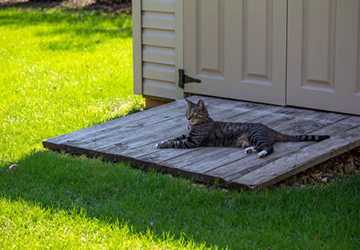Cats are endowed with a natural curiosity that often propels them to explore beyond the protective confines of their domestic habitat. Permitting your cat to traverse the outdoors necessitates a reasonable assessment to safeguard their welfare and vitality.

Evaluating Risks and Enacting Precautions
Before settling on when to let your cat outside, weighing potential perils and taking preventive measures are paramount. The external environment harbours various threats for felines, encompassing vehicular traffic, predatory wildlife, infectious ailments, and the peril of displacement.
Scrutinizing Your Immediate Locale
- Safety Assessment of Surroundings: Scrutinize the security level of your locale. Are vehicular thoroughfares prevalent? Are there predatory species that could pose threats?
- Recognition of Environmental Hazards: Detect possible dangers in your vicinity that could jeopardize your cats, such as toxic flora, unguarded aquatic bodies, or antagonistic neighbours.
Preventative Health Measures and Identification
- Health Protocols: Ensure your cat is current with all vaccinations and has been declared healthy by a veterinary examination before they embark on outdoor explorations.
Robust Identification Solutions: Outfit your cat with a durable collar and an easily discernible ID tag. Microchipping serves as an additional safeguard, facilitating your pet's recovery should it wander afar.
Fostering Outdoor Proficiencies in Your Cat
Implementing methodical training can substantially augment your cat’s security outdoors. Explore these training modalities:
Acclimatization to Harness and Leash
- Indoor Habituation: Initially, condition your cat to accept a harness and leash within the safe bounds of the home.
- Incremental Exposure to the Outdoors: Gradually acquaint your cat with outdoor settings, initiating brief, closely supervised excursions.
Controlled Outdoor Engagement
- Confinement to Protected Spaces: Contemplate the creation of a dedicated outdoor cat enclosure where your feline can relish the outdoors devoid of the risks tied to free roaming.
- Diligent Oversight: Maintain vigilant supervision over your cat during outdoor forays to ensure their safety.
Optimal Timing for Outdoor Exposure
You are deciding when to let your cat outside hinges on understanding your cat's disposition, health status, and the security of your environmental setting. The rate at which cats acclimate to outdoor conditions can vary significantly.
Strategies for Safe Outdoor Engagements
- Timing of Outdoor Visits: Favor daylight hours for your cat's outdoor time when oversight is more feasible and predatory threats are minimized.
Weather Considerations: Do not allow your cat outdoors during inclement weather conditions, such as heavy snow, rainstorms, or severe heat waves.
Assessing the Safety of Outdoor Access for Cats
Is it safe for cats to go outside? This query warrants a tailored response, contingent upon specific circumstances. Consider these factors:

Advantages of Outdoor Access
- Physical Health Enhancement: Outdoor activities can contribute significantly to maintaining your cat's physical robustness.
- Mental Enrichment: The natural world's diverse sensory inputs can keep your cat mentally sharp and engaged.
Dangers Associated with Outdoor Access
- Increased Exposure to Risks: Cats with outdoor privileges face heightened risks of physical harm, illnesses, and unforeseen incidents.
- Implications for Lifespan: Statistical data suggests that the life expectancy of outdoor cats may be curtailed due to these elevated risks.
Imperative Outdoor Safety Protocols for Cats
Allowing your cat outdoor privileges mandates stringent safety measures to ensure a secure outdoor experience. Here are essential outdoor safety tips for cats:
Regular Health Surveillance
- Consistent Veterinary Oversight: Ensure your cat receives regular health evaluations to maintain overall well-being.
- Proactive Parasite Defense: Adopt a preventive regimen against fleas and ticks to shield your cat from parasites and their propagating diseases.
Regulated Access to the Outdoors
- Establishment of a Secure Enclosure: Erecting a 'catio' provides a safe platform for your cat to enjoy the outdoors while mitigating free-roaming risks.
Utilization of Tracking Technologies: Invest in advanced GPS tracking devices attached to your cat's collar, which enable real-time location monitoring.
Facilitating the Transition to Outdoor Exploration
When transitioning your feline from a strictly indoor lifestyle to experiencing the great outdoors, a meticulous approach can substantially augment their security and pleasure.
Behavioral Acclimatization
- Positive Reinforcement: Employ treats and expressions of affection to motivate your cat as it acclimates securely to the outdoor environment.
- Measured Progression: Incrementally extend the duration of outdoor excursions to allow your cat to adapt to the novel surroundings with minimal stress.
Environmental Acclimation
- Territorial Scent Marking: Permit your cat to inspect your garden or yard under close supervision to lay down their scent markers, fostering a sense of security in their new domain.
Established Safe Havens: Provide secure locations where your cat can seek refuge or conceal itself if it feels menaced or overpowered.
Enhanced Safety Protocols
Surpassing rudimentary preparations, enhanced safety measures can significantly fortify your cat’s ventures outdoors.
Sophisticated Monitoring Techniques
- Video Surveillance Systems: Contemplate the installation of external cameras to oversee your cat’s movements and intercede if necessary.
- Perimeter Alerts: Certain GPS tracking devices include functionalities that notify you if your cat breaches a predetermined boundary.
Wellness Enhancements
- Nutritional Modifications: Modify your cat’s nourishment to bolster their increased physical exertion during regular outdoor explorations.
- Vigilance in Fitness: Continuously monitor your cat’s physical state to ensure they maintain optimal health and agility.
Socio-legal Implications
Comprehending and adhering to local statutes and community standards is vital in effectively managing your cat's time outdoors.
Adherence to Local Wildlife Ordinances
- Regulatory Awareness: Stay informed about regional wildlife conservation statutes that could impact your cat’s freedom to roam.
- Mitigation of Ecological Impact: Evaluate and mitigate the possible effects your cat could impose on local avian populations and small fauna.
Fostering Neighborhood Amity
- Neighborly Communications: Maintain an open dialogue with your neighbours about your cat's presence outdoors to preempt disputes or grievances.
- Ethical Pet Stewardship: Monitor your cat’s interactions and maintain cleanliness in their outdoor surroundings to prevent them from becoming a community irritant.
Conclusion
The decision to allow your cat to explore outdoors is a significant one that should be approached with meticulous care and responsibility. By thoroughly understanding the risks and instituting appropriate safety protocols, you can help ensure that your cat enjoys the outdoors while minimizing potential dangers. Regular reevaluation of whether it is for cats to go outside is advised, with adjustments to your strategies based on changes in your environment or your cat's health.
-
Upgraded Comfort Foods: Classic Dishes With A Gourmet Twist
Comfort food has always been synonymous with feelings of warmth, nostalgia, and simplicity. These dishes take us back to moments shared with family or childhood favourites that have become staples in our kitchens. However, in recent years, the culinary world has seen a rise in reimagined versions of these classics. Combining the rich flavours we love with gourmet techniques and ingredients, these dishes offer a modern take on timeless comfort food.
-
When to Transition from Puppy Food to Adult Dog Food
The transition from puppy food to adult dog food is climacteric for their maturation and well-being. As canines age, their dietary requirements transform, and the caloric and protein-packed puppy sustenance that was once advantageous may turn superfluous, potentially resulting in health complications such as adiposity. Conscientious pet owners must discern the appropriate moment for this transition to ensure optimal health outcomes for their furry companions. This detailed exposition elucidates the critical timing and considerations in transitioning a puppy to adult dog food.
-
Why Choose a Ferret as Your Furry Companion?
When people embark on the journey of pet ownership, the limelight typically falls on animals like dogs or cats. Ferrets, however, offer a unique blend of qualities that are often overlooked but incredibly rewarding.